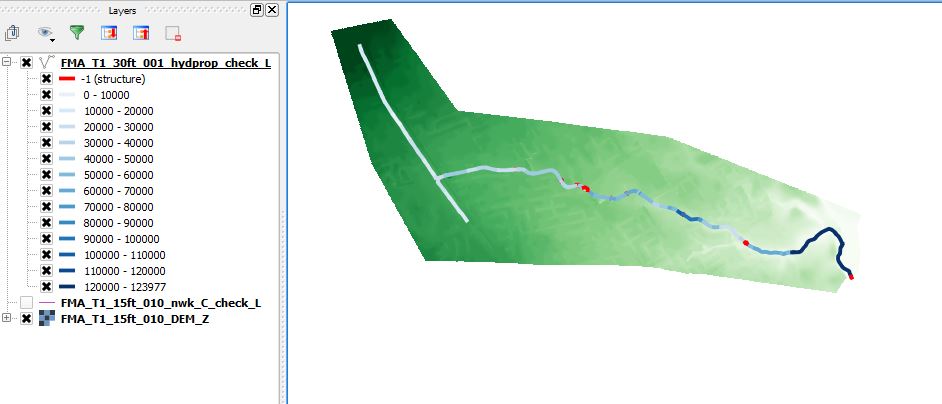Check Files 1d hydroprop: Difference between revisions
Jump to navigation
Jump to search
Content deleted Content added
No edit summary |
No edit summary |
||
| (2 intermediate revisions by the same user not shown) | |||
| Line 12: | Line 12: | ||
| DS_Node_ID||The downstream node ID for the channel. |
| DS_Node_ID||The downstream node ID for the channel. |
||
|- |
|- |
||
| Channel_Type||The channel type, see |
| Channel_Type||The channel type, see the <u>[https://docs.tuflow.com/classic-hpc/manual/latest/ TUFLOW Manual]</u> for a list of channel types.<br> |
||
For example an '''"S"''' type channel is a standard open channel, an '''"R"''' type channel is a rectangular culvert. |
For example, an '''"S"''' type channel is a standard open channel, an '''"R"''' type channel is a rectangular culvert. |
||
|- |
|- |
||
| Manning_n||The primary Manning's n value for the channel. If this varies across the channel, e.g. an open channel with cross-section, the Manning's n value at the lowest point is reported.<br> |
| Manning_n||The primary Manning's n value for the channel. If this varies across the channel, e.g. an open channel with cross-section, the Manning's n value at the lowest point is reported.<br> |
||
For some new structures this is the Cd coefficient. |
For some new structures this is the Cd coefficient. |
||
|- |
|- |
||
| Elev_at_Top||The highest elevation in the channel, for an open channel, this is the high point in the cross-section. For a structure the average channel obvert is output (calculated by adding the pipe height to the upstream and downstream invert levels and taking the average). Note that the water level can rise above this. See the |
| Elev_at_Top||The highest elevation in the channel, for an open channel, this is the high point in the cross-section. For a structure the average channel obvert is output (calculated by adding the pipe height to the upstream and downstream invert levels and taking the average). Note that the water level can rise above this. See the ECF command <font color="blue"><tt>Depth Limit Factor</font><font color="red"> == </font></tt> in the <u>[https://docs.tuflow.com/classic-hpc/manual/latest/ TUFLOW Manual]</u> for more information on this. |
||
|- |
|- |
||
| Depth||The depth of the channel at the top elevation (see above). |
| Depth||The depth of the channel at the top elevation (see above). |
||
| Line 32: | Line 32: | ||
The hydraulic properties at the top of the channel can be very useful to map to ensure there are no sudden changes in channel geometry or input data that can stability issues. An example of mapping the conveyance in GIS can be found here:<br> |
The hydraulic properties at the top of the channel can be very useful to map to ensure there are no sudden changes in channel geometry or input data that can stability issues. An example of mapping the conveyance in GIS can be found here:<br> |
||
* [[MapInfo_Style_Check_Files# |
* [[MapInfo_Style_Check_Files#Example_Mapping_1D_TSMB.mif_Layer_.28To_Diagnose_Instability_Locations.29 | Mapinfo thematically mapping of hydroprop check file]] |
||
* QGIS (to be created) |
* QGIS (to be created) |
||
* ArcMap (to be created) |
* ArcMap (to be created) |
||
| Line 39: | Line 39: | ||
The image below shows a hydroprop layer styled by the conveyance attribute.<br> |
The image below shows a hydroprop layer styled by the conveyance attribute.<br> |
||
[[File:Check Files 1d hydroprop 01.jpg]] |
[[File:Check Files 1d hydroprop 01.jpg]] |
||
<br><br> |
|||
{{Tips Navigation |
|||
|uplink=[[TUFLOW_Check_Files | TUFLOW Check Files]] |
|||
}} |
|||
Latest revision as of 09:44, 23 September 2024
This file contains information on the hydraulic properties of the 1D channels.
Attributes of hydprop_check
| Attribute Name | Attribute Description |
|---|---|
| ID | The channel ID. |
| US_Node_ID | The upstream node ID for the channel. |
| DS_Node_ID | The downstream node ID for the channel. |
| Channel_Type | The channel type, see the TUFLOW Manual for a list of channel types. For example, an "S" type channel is a standard open channel, an "R" type channel is a rectangular culvert. |
| Manning_n | The primary Manning's n value for the channel. If this varies across the channel, e.g. an open channel with cross-section, the Manning's n value at the lowest point is reported. For some new structures this is the Cd coefficient. |
| Elev_at_Top | The highest elevation in the channel, for an open channel, this is the high point in the cross-section. For a structure the average channel obvert is output (calculated by adding the pipe height to the upstream and downstream invert levels and taking the average). Note that the water level can rise above this. See the ECF command Depth Limit Factor == in the TUFLOW Manual for more information on this. |
| Depth | The depth of the channel at the top elevation (see above). |
| Flow_Width | The flow width at the top of channel. |
| Storage_Width | The storage width at the top of the channel. |
| Flow_Area | The flow area at the top of the channel. |
| Conveyance | The conveyance value at the top of the channel. This is -1 for some structure channels. |
The hydraulic properties at the top of the channel can be very useful to map to ensure there are no sudden changes in channel geometry or input data that can stability issues. An example of mapping the conveyance in GIS can be found here:
- Mapinfo thematically mapping of hydroprop check file
- QGIS (to be created)
- ArcMap (to be created)
The image below shows a hydroprop layer styled by the conveyance attribute.

| Up |
|---|